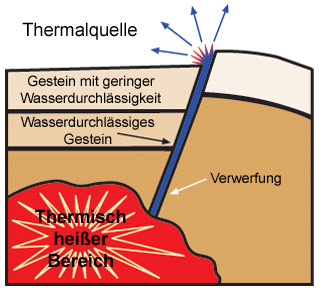Leonorenquelle EarthCache
-
Difficulty:
-

-
Terrain:
-

Size:  (not chosen)
(not chosen)
Please note Use of geocaching.com services is subject to the terms and conditions
in our disclaimer.
Die Leonorenquelle in Bad Salzig ist eine Mineralquelle, ein
Mineralbad und ein Säuerling. Das Quellwasser ist an dieser Stelle
sowie in der Trinkhalle der LVA zugänglich. Auch das moderne
Schwimmbad der LVA (Thermalbad) wird mit Quellwasser
gespeist.
Die Anfänge der Mineralquelle gehen in die Römerzeit zurück. Im 18.
und 19. Jahrhundert werden mehrfach Salzbrunnen erwähnt. 1840 gab
es erste Bemühungen um die Nutzung der Mineralquellen. Sie wurde
dann von 1902-1905 im Auftrag von Hauptmann i. R. Theodor Hoffmann,
nachdem er 1889 das Quellenareal gekauft hat, gebohrt. Aus fast
500m Tiefe sprudelt das 28° warme Heilwasser der
kohlensäurehaltigen, alkallisch-muratischen
Glaubersalzquelle.
Nach den heutigen „Begriffsbestimmungen für Kurorte,
Erholungsorts und Heilbrunnen“ des Deutschen Bäderverbandes
und des Deutschen Fremdenverkehrsverbandes ist das Wasser der
„Leonorenquelle“ in Bad Salzig als ein
„Natrium-Chlorid-Hydrogencarbonat-Sulfat-Wasser“ zu
kennzeichnen. In der hochmodernen Mittelrheinklinik der LVA
Rheinland-Pfalz finden die Kurgäste Heilung bei Magen-, Darm-,
Leber-, Galle- und Stoffwechselerkrankungen.
Man sagt, dass das Wasser aus Mineralquellen die Handschrift der
Gesteine trägt, über welches es geflossen ist. Sie enthalten in
wässriger Lösung jene Stoffe, die sich aus dem Stein herauslösen
lassen und sind demnach ein Abbild der Geologie und der Zeit. Die
Gesteinsmineralien bestimmen die Inhaltsstoffe des Lösemittels
Wasser, und die Kontaktzeit ist massgebend für die Konzentration.
Aufgrund der Zusammensetzung an gelösten Mineralien kann man
Rückschlüsse auf die Gesteine im Untergrund ziehen und abschätzen,
wie lange das Wasser mit ihnen in Kontakt gewesen sein muss.
Desweiteren kann man Rückschlüsse ziehen, wie die Gesteine sich
gebildet haben.
Das Wasser wird durch die sandig-schiefrige Fazies mit
Porphyroiden, die sogenannten Singhofen-Schichten, so gefiltert,
dass es einen ganz eigenen Geschmack bekommt.
Hier ein Auszug der Inhaltsstoffe der Leonorenquelle:
| Inhaltsstoff |
Gehalt(mg/l) |
| Natrium (Na) |
1480 |
| Kalium (K) |
46,0 |
| Ammonium (NH4) |
5,9 |
| Magnesium (Mg) |
25,6 |
| Calcium (Ca) |
104 |
| Chlorid (Cl) |
1010 |
| Sulfat (SO4) |
844 |
| Hydrogencarbonat (HCO3) |
1621 |
| Carbonat (CO3) |
< 3 |

Bitte beantworte folgende Fragen um den Cache zu loggen:
- Aus welcher Tiefe (lt. Informationstafel) wird das Wasser
nach oben befördert?
- Wie viele Entnahmestellen findest du hier (im Winter nicht
in Betrieb)?
The Leonor source in Bad Salzig is a mineral spring, a Mineral bath
and a sparkling. The spring water is at this point and accessible
in the pump room of the LVA. Even the modern Swimming pool of the
LVA (thermal) is with spring water fed.
The beginnings of the mineral source to go back to Roman times. In
the 18 and 19 Century are mentioned several times salt wells. 1840
was It first attempts to use the mineral springs. It was then from
1902-1905 on behalf of Captain Theodor Hoffmann, after he bought in
1889 the source area, drilled. For almost 500m depth, the bubbling
hot spa water of 28 ° carbonated, alkallisch-Murat Glauber's salt
spring.
According to today's "definitions for spas, Resort and healing
fountain"of the Deutschen Bäderverbandes and the German Tourism
Association is the water of "Leonor source" as in a salty bath
"Sodium-chloride-bicarbonate-sulfate water" mark. In the
ultra-modern hospital of the Mittelrheinklinik der LVA
Rheinland-Pfalz spa guests will find the cure for stomach, colon,
Liver, bile and metabolic diseases.
It is said that the water from mineral springs, the manuscript of
the Carries rocks, over which it has flowed. They contain aqueous
solution of the substances, which detach themselves from the stone
and can therefore be a reflection of the geology and time. The Rock
minerals determine the ingredients of the solvent Water, and the
contact time is indicative of the concentration. Because of the
composition of dissolved minerals can be Draw conclusions about the
rocks in the subsurface and assess how long the water with them
must have been in contact. Furthermore, one can draw conclusions
about how the rocks are have formed.
The water is through the sandy-schistose facies porphyoïdes, the
so-called Singhofen layers, filtered so that there is a gets very
own taste.
In the table above you find an excerpt of the contents of Leonor
Source.
Please answer the following questions to log the cache:
- From what depth the water is transported to the top
(according to information board)?
- How many outlets can be found here (not in winter
Operation)

Additional Hints
(No hints available.)